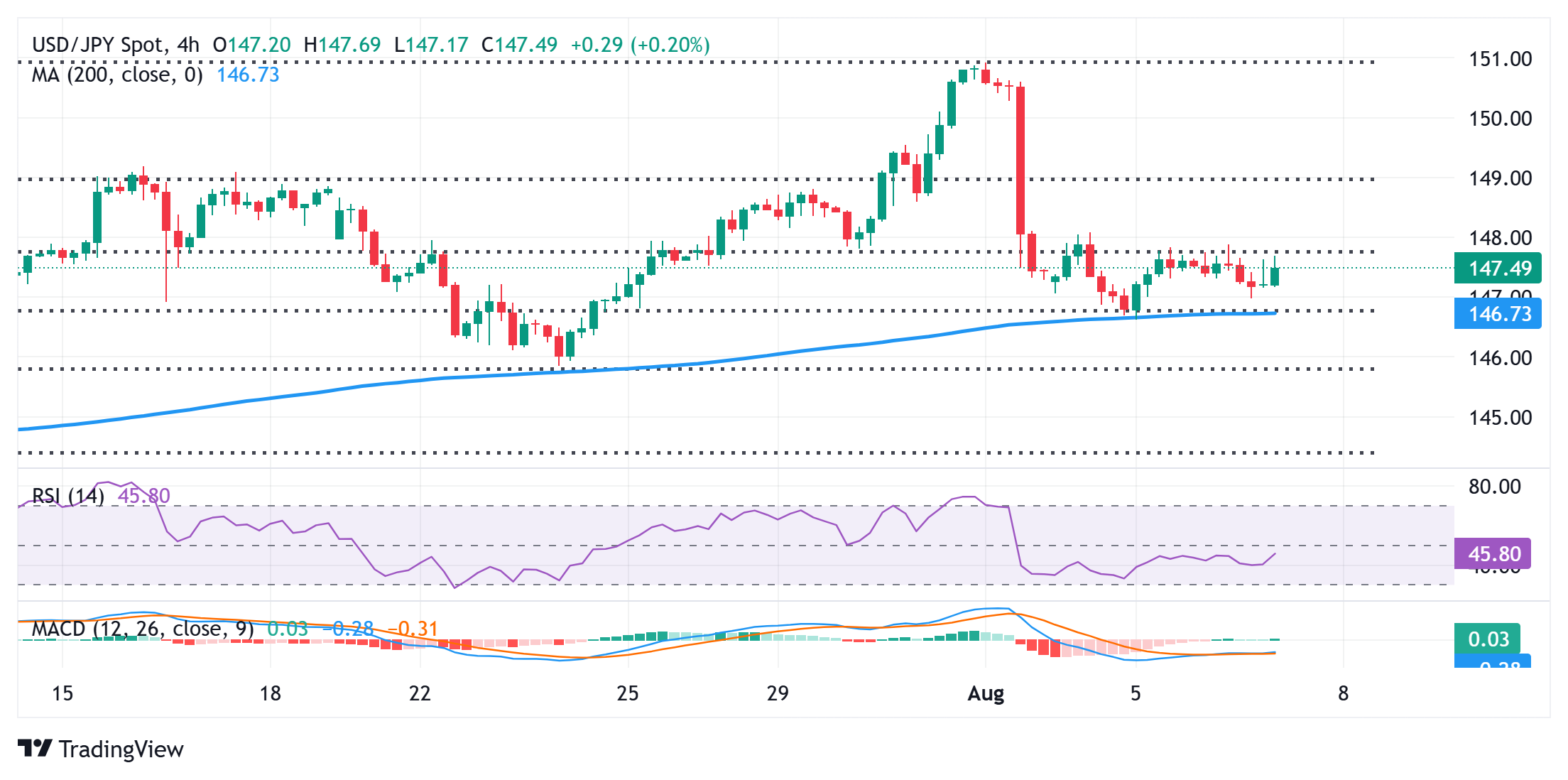Created
: 2025.08.07














![]() 2025.08.07 11:40
2025.08.07 11:40
The Japanese Yen (JPY) weakens slightly during the Asian session on Thursday in reaction to reports that US President Donald Trump could impose an additional 15% tariff on all Japanese imports. This, along with the uncertainty over the likely timing of the next interest rate hike by the Bank of Japan (BoJ) and a generally positive risk tone, undermines the safe-haven JPY. Apart from this, a modest US Dollar (USD) bounce from over a one-week low touched on Wednesday pushes the USD/JPY pair back above mid-147.00s in the last hour.
Meanwhile, the BoJ last week left the door open for a further interest rate hike by the end of this year. In contrast, the Federal Reserve (Fed) is widely expected to lower borrowing costs at the September policy meeting, which could cap the attempted USD recovery. Furthermore, the divergent BoJ-Fed policy outlook could act as a tailwind for the lower-yielding JPY and warrants caution for bearish traders. This makes it prudent to wait for some follow-through buying before positioning for any further appreciating move for the USD/JPY pair.

From a technical perspective, this week's rebound from the 200-period Simple Moving Average (SMA), around the 146.60 area, or the weekly low, and the subsequent move up favors the USD/JPY bulls. However, oscillators on the said chart are yet to confirm the positive outlook. Moreover, spot prices, so far, have been struggling to clear the 38.2% Fibonacci retracement level of the upswing from the July monthly low. This, in turn, makes it prudent to wait for a sustained move beyond the 147.80-147.85 region before positioning for any further gains. The currency pair might then surpass the 148.00 round figure and climb to the 148.45-148.50 region. The momentum could extend further towards the 149.00 neighborhood, or the 23.6% Fibo. retracement level.
On the flip side, the Asian session low, around the 147.15 region, closely followed by the 147.00 mark, could offer immediate support to the USD/JPY pair ahead of the 146.75 confluence. The latter represents the 200-period SMA on the 4-hour and the 50% Fibo. retracement level, which, if broken decisively, should pave the way for deeper losses. Spot prices might then accelerate the fall towards testing sub-146.00 levels, or the 61.8% Fibo. retracement level. Some follow-through selling below the latter could expose the 145.00 psychological mark.
Tariffs are customs duties levied on certain merchandise imports or a category of products. Tariffs are designed to help local producers and manufacturers be more competitive in the market by providing a price advantage over similar goods that can be imported. Tariffs are widely used as tools of protectionism, along with trade barriers and import quotas.
Although tariffs and taxes both generate government revenue to fund public goods and services, they have several distinctions. Tariffs are prepaid at the port of entry, while taxes are paid at the time of purchase. Taxes are imposed on individual taxpayers and businesses, while tariffs are paid by importers.
There are two schools of thought among economists regarding the usage of tariffs. While some argue that tariffs are necessary to protect domestic industries and address trade imbalances, others see them as a harmful tool that could potentially drive prices higher over the long term and lead to a damaging trade war by encouraging tit-for-tat tariffs.
During the run-up to the presidential election in November 2024, Donald Trump made it clear that he intends to use tariffs to support the US economy and American producers. In 2024, Mexico, China and Canada accounted for 42% of total US imports. In this period, Mexico stood out as the top exporter with $466.6 billion, according to the US Census Bureau. Hence, Trump wants to focus on these three nations when imposing tariffs. He also plans to use the revenue generated through tariffs to lower personal income taxes.
![]()
Created
: 2025.08.07
![]()
Last updated
: 2025.08.07

FXStreet is a forex information website, delivering market analysis and news articles 24/7.
It features a number of articles contributed by well-known analysts, in addition to the ones by its editorial team.
Founded in 2000 by Francesc Riverola, a Spanish economist, it has grown to become a world-renowned information website.
We hope you find this article useful. Any comments or suggestions will be greatly appreciated.
We are also looking for writers with extensive experience in forex and crypto to join us.
please contact us at [email protected].
Disclaimer:
All information and content provided on this website is provided for informational purposes only and is not intended to solicit any investment. Although all efforts are made in order to ensure that the information is correct, no guarantee is provided for the accuracy of any content on this website. Any decision made shall be the responsibility of the investor and Myforex does not take any responsibility whatsoever regarding the use of any information provided herein.
The content provided on this website belongs to Myforex and, where stated, the relevant licensors. All rights are reserved by Myforex and the relevant licensors, and no content of this website, whether in full or in part, shall be copied or displayed elsewhere without the explicit written permission of the relevant copyright holder. If you wish to use any part of the content provided on this website, please ensure that you contact Myforex.
Myforex uses cookies to improve the convenience and functionality of this website. This website may include cookies not only by us but also by third parties (advertisers, log analysts, etc.) for the purpose of tracking the activities of users. Cookie policy